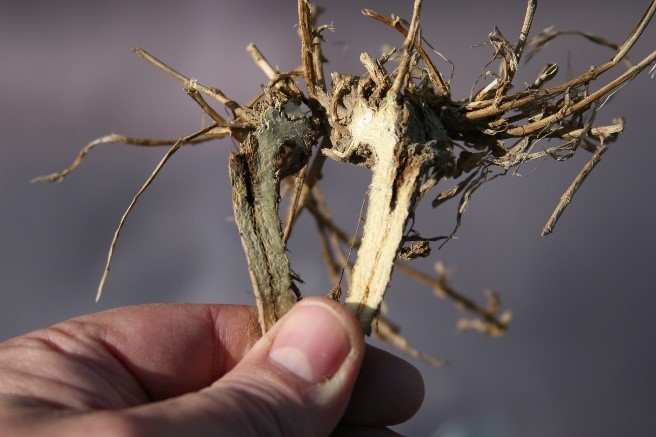
- Several factors can increase the chances of winter injury to alfalfa.
- Winter injury can be diagnosed by evaluating alfalfa stands for symptoms of damage.
- Weather conditions that increase the chances of winter injury (including frost heaving), are primarily bitter cold with no snow cover, ice sheeting, and wide temperature fluctuations.
- With the below freezing nighttime temperatures predicted in the 10- day forecast, make sure to assess alfalfa stands that have broken dormancy for any symptoms of frost damage.
Several factors may impact winter injury and survival of alfalfa stands. Older stands, varieties that lack superior winter-hardiness or disease resistance, low soil pH, low soil fertility (particularly potassium), fall cutting between September 1 and October 15, all can increase the likelihood of winter injury. These stresses are additive, so the more stresses a field has endured, the greater the chances of winter injury.
Weather conditions that increase the chances of winter injury (including frost heaving) are primarily bitter cold with no snow cover, ice sheeting, and wide temperature fluctuations. Injury can be as obvious as dead plants and reduced stands or perhaps less noticeable, as low tonnage or reduced forage quality. An alfalfa field that is slow to green up this spring should be examined closely for signs of winter injury.
Dennis Cosgrove and Dan Undersander, forage specialists with the University of Wisconsin, developed the following guidelines for diagnosing winter injury and managing damaged stands. We have added to the guidelines. Look for the following symptoms:
Frost Heaving: Frost heaving is elevation of the alfalfa crown above the soil surface. This occurs when frequent freezing and thawing of soils cause soil expansion and contraction that squeezes the alfalfa taproot, forcing it upward in the soil. This will often result in breakage of lateral roots. This type of damage is especially common on fine textured, water saturated soils.
Asymmetrical Growth: Buds for spring growth were formed last fall. If parts of an alfalfa root have been killed, only the living portion of the crown will give rise to new shoots.
Uneven Green-Up and Growth: If some buds on the crown have been injured while others have not, the uninjured buds will start growth early while the killed buds must be replaced with new buds before growth can begin.
Root Damage: Plants should be dug up to a depth of at least 4 to 6 inches and then the taproot should be split lengthwise with a knife. Winter killed roots will have a gray, water-soaked appearance just after the soil thaws. Once water leaves the root, the tissue will turn brown, dehydrated and stringy. If the root is soft and water can easily be squeezed from it, or is brown, stringy and dehydrated, it is most likely winter killed. Also, if 50% or more of the root is blackened from root rot, the plant will most likely die during spring green up, or later in the year. A healthy root should be firm and white with little evidence of root rot.
Spring frost injury to alfalfa coming out of dormancy has been observed in regions were the nighttime low temperatures have fallen into the 20’s. Light frost damage can occur when alfalfa plants are exposed to temperatures between 27°F and 31°F. Some trifoliate leaves may be lost due to the cold temperatures, but growing points are likely to be unharmed and alfalfa will outgrow the damage with no additional management needed. When low temperatures range from 26°F to 27°F, moderate frost damage can be observed. Growing point injury can be observed at the end of the stems. The whole stem will not be dead, just the end furthest from the crown. Forage quality can be affected by a moderate frost and delaying harvest may help to allow for greater recovery, but forage quality will not fully recover. Severe frost damage will occur if temperatures plummet below 26°F. Stems will likely be killed, and not regrow, and if they do, the regrowth will grow directly from the crown. Harvest should be delayed if temperatures fall into the low-to-mid 20’s to allow for greatest recovery. View more information on frost damage to alfalfa here:
http://www2.ca.uky.edu
Image: Crown Rot Symptoms in Winter-Injured Alfalfa
Sources: University of Kentucky